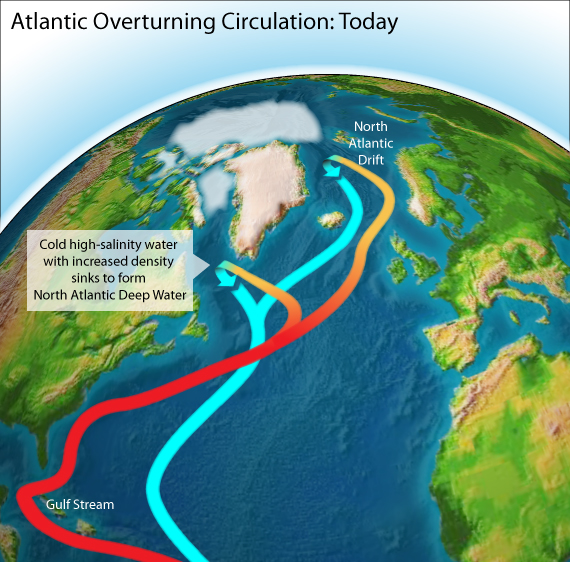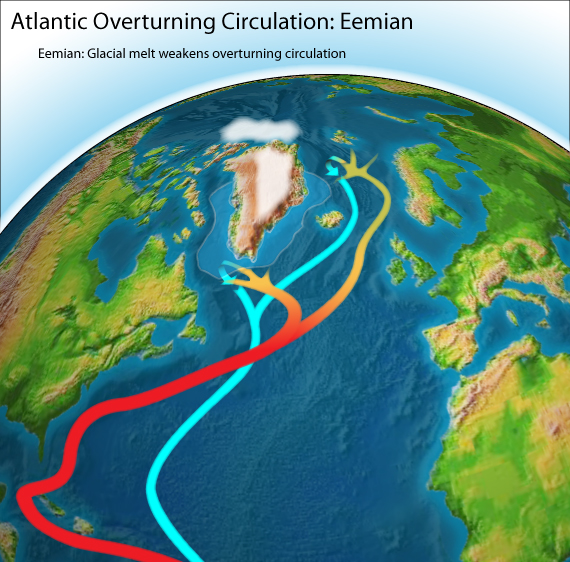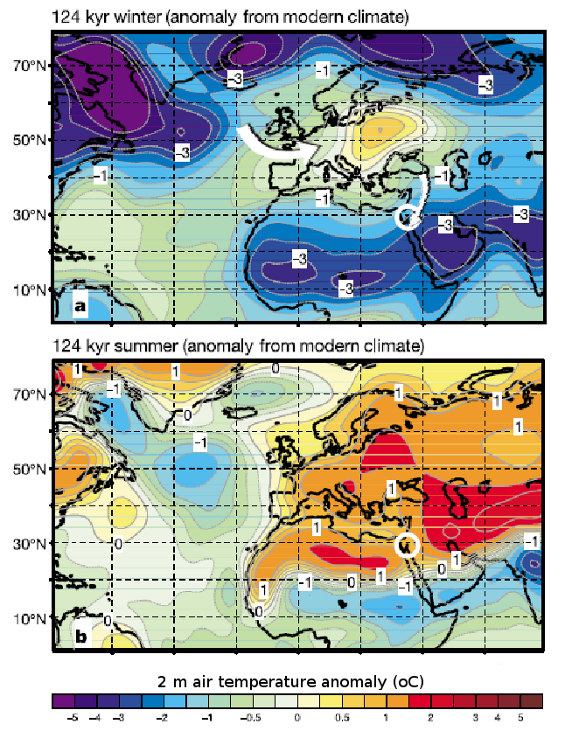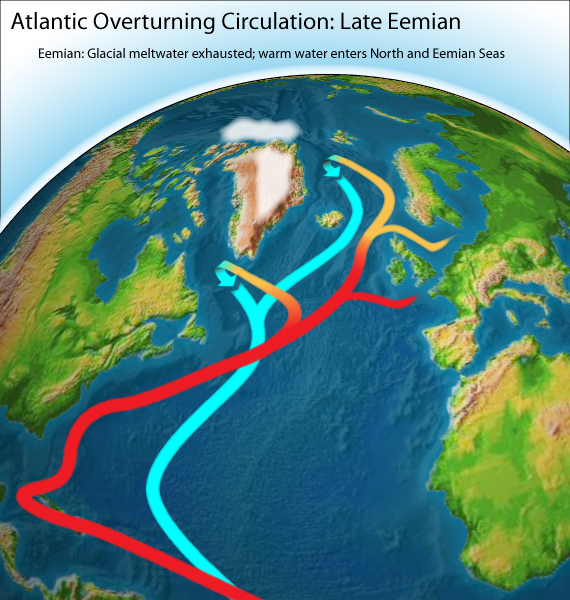The Last Interglacial Part Four - Oceanic Influences
Posted on 3 October 2011 by Steve Brown
NOTE: This is the fourth article of a five-part series on what we can learn from the Last Interglacial time period. Understanding this period may provide clues on how the environment may respond to similar conditions in the future. In the first post, we described the conditions that exisited during the Last Interglacial. In the second post, we looked at the key factors for making it a warm period. In the third post, we looked at how sea-levels rose as a result of melting ice-sheets. In this post, we examine how the Last Interglacial oceans influenced the climate.
In the previous posts we learned that the Last Interglacial, also known as the Eemian in Europe, was significantly warmer than today in large regions of the Northern Hemisphere, and may have been around 1oC warmer globally. The main reason for this warmer climate was an increased amount of energy from the Sun being received at high northern latitudes due to Earth's orbital configuration, plus Earth had an increased capacity to absorb heat due to vegetation changes and reduced ice and snow cover. This warmer climate led to significant melting of the Greenland and Antarctic Ice Sheets. As well as contributing to a global sea-level rise of several metres, the large volume of meltwater released to the ocean also had an effect on the climate.
It's long been known that the Gulf Stream has a significant role in maintaining a mild climate in Northern Europe by the transport of heat far into the North Atlantic. The Gulf Stream is part of a larger circulation system called the Atlantic Meridional Overturning Circulation (AMOC). The AMOC is closely related to the thermohaline circulation, which is driven by temperature and salinity changes. Meridional Overturning Circulation includes the action of wind, as well as density changes through differences in temperature and salinity in order to drive the ocean currents.

Figure 1: Meridional Overturning Circulation in the Atlantic today (illustration by jg. Source for Earth's topology: NASA/JPL-Caltech)
In recent years there has been a huge debate on how global warming may impact the Gulf Stream and the AMOC. A major consideration is the potential for a slowdown or stop of the AMOC in response to freshwater from the melting of the Greenland Ice Sheet, which lowers the density of the surface waters and puts the brakes on the thermohaline component of the AMOC. The AMOC has a considerable influence over European climate from the northward heat transport by the Gulf Stream and a slowdown or halt of the AMOC could have a large impact on climate and even induce abrupt climate changes (Alley et al, 2002; Alley, 2007). The IPCC Assessment Report 4 considered various models, estimating up to a 50% slowdown in the AMOC by 2100, though none predicted a complete halt. More recent studies support the view that it is very unlikely that the AMOC will undergo any abrupt transition this century (Allison et al., 2009). Though, between 1957 and 2004 there are indications of a 30% slowdown in the AMOC at 25oN (Bryden et al., 2005). Keenlyside et al. (2008) forecasts that the AMOC will weaken over the next decade, but they argue that large uncertainties exist in previous measurements of AMOC variability due to poor observation and modelling analyses. Recently, Willis (2010) used satellite observations of sea surface height and sensor buoy observations of velocity, salinity and temperature of the Atlantic Ocean at 41oN and found no significant change in the AMOC strength between 2002 and 2009. Despite interannual fluctuations, observations show that it's unlikely there has been any significant slowing of the AMOC during the past 20 years.
Surface freshwater plays an important role for ocean circulation by its influence on the formation of deep water masses. A stronger deep circulation may increase northward heat transport by the AMOC, while a weaker deep circulation may promote less northward heat transport (Born et al., 2009). Barreiro et al. (2008) found that northern Atlantic waters have freshened rapidly in the past few decades and heat transported northward by the thermohaline circulation has decreased. It's expected that this freshening could increase further through intensified high-latitiude precipitation and glacial melt-water related to global warming. Vellinga et al. (2008) examined various model results that attempt to quantify how the AMOC responds to different melt-water fluxes from Greenland. In one model a large enough flux, or rate of flow, of melt-water to shutdown the AMOC was created, which resulted in a cooling of surface air temperature in excess of 15oC over the Norwegian and Barents Seas, with a lesser degree of cooling over the whole hemisphere. Most models that investigate increasing greenhouse gas scenarios predict that the AMOC will slow down as a result of such forcing (Driesschaert et al., 2007; Meehl et al., 2007). However, other model results suggest that anthropogenic aerosols may have delayed a greenhouse gas induced weakening of the AMOC by reflecting inbound solar radiation and partially offsetting greenhouse gas warming.
Hodell et al. (2009) present evidence for a slowdown of the AMOC during the early part of the Last Interglacial from proxy data taken from marine core sediment in the Iceland basin. They suggest that slow current speed detected at the locality may have been the result of an increased meltwater flux in the Nordic Seas due to peak summer insolation. Their findings indicate that the slowdown of circulation happened when climate was warmer than present and the Greenland Ice Sheet was in retreat. This slowdown is supported by computer modelling studies of the Last Interglacial, which estimates that the AMOC was ~20% weaker between 127 and 125 ka (Groger et al., 2007). Using pollen based climate reconstructions, Field et al. (1994) suggest that instability of the AMOC due to high summer insolation and increased precipitation may have led to cold winters in northern Europe. However, this situation ended when the freshwater flux from ice-sheet melting decreased and a newly enhanced thermohaline circulation in the Atlantic was likely to have extended the interglacial warmth during the latter part of the Last Interglacial. This additional heat transport may also have increased snowfall in Arctic regions through enhanced evaporation and precipitation, facilitating the return to glacial conditions (McManus et al., 2002).

Figure 2: Meridional Overturning Circulation during the early-mid Eemian (illustration by jg. Source for Earth's topology: NASA/JPL-Caltech)
According to Felis et al. (2004), the major influences on climatic variability in the Northern Hemisphere are the Arctic Oscillation and North Atlantic Oscillation, which are regions of atmospheric pressure differences that can guide weather systems on a seasonal basis. The North Atlantic Oscillation is a fluctuation of atmospheric pressure measured between Iceland and the Azores, which can determine the seasonal weather patterns of Europe, North Africa and the Middle East. A large pressure difference, called a high-index state, in the North Atlantic Oscillation typically causes the Gulf stream to flow stronger, bringing warmer and wetter weather to Europe. A low pressure difference (a low index state) does the opposite, with generally drier and cooler weather to Europe. The Arctic Oscillation can determine the track of the jet stream, which either flows West to East, keeping the cold polar air trapped in the Arctic, or it loops southward bringing cold polar air to Europe. A climate record of the Last Interglacial from corals in the Red Sea show evidence of a high index state of the North Atlantic Oscillation leading to increased seasonality between winter and summer temperatures in the Middle East compared to the present day. Warmer summer temperatures were a direct result of increased summer insolation, with the colder winters possibly related to North Atlantic Oscillation influences such as increased cold air advecting from the North.

Figure 3: LIG summer and winter temperature anomaly from present day (Felis et al., 2004)
Lisiecki et al. (2008) analysed orbital responses in proxy indicators of oceanic overturning and found that the AMOC is sensitive to maxima in the obliquity and precession components of the Earth's orbit around the Sun. The component of the AMOC in the Nordic Seas show signs of responding rapidly to orbital forcing.
North Atlantic Deep Water (NADW) is a distinct mass of deep salty and cold water that forms from the growth of Arctic sea-ice, which leaves behind a dense brine that sinks and contributes to the thermohaline circulation. A link between Earth's orbital eccentricity and NADW production with high eccentricity leading to low production of NADW and vice versa is proposed by Crowley and Kim (1992). This orbital influence may possibly be explained by circulation changes from strong temperature contrasts between land and sea. Low production of NADW will decrease thermohaline circulation. Some climate models of the Last Interglacial indicate that a high-index state of the North Atlantic Oscillation, bringing cool summers and mild winters to Europe, is favoured due to the configuration of orbital parameters. Less vigorous ocean circulation in the North Atlantic has been associated with positive phases of North Atlantic Oscillation. If peak summer insolation during the early Last Interglacial favoured a persistent positive North Atlantic Oscillation, then this may have contributed to slow circulation from ~128 to 124.5 ka. (Hodell et al., 2009).
Seidenkrantz & Knudsen (1997) proposed that higher sea level may have allowed warm water from the North Atlantic Drift, which forms from the northerly reaches of the Gulf Stream, to pass through the English Channel into the North Sea during the Last Interglacial. A stronger North Atlantic Drift would increase the flow of warm water into the North Sea past northern Britain. Sea-surface temperatures in the English Channel were 1 to 3oC warmer during the Last Interglacial compared to today, while in the Kattegat between Denmark and Sweden, sea-surface temperatures were up to 8oC higher than today. These higher sea-surface temperatures may be explained by a stronger North Atlantic drift, and more open connections between the North Sea and White Sea due to higher sea level and the formation of the Eemian Sea (Burman & Passe, 2008).
Figure 4: Meridional Overturning Circulation in the Atlantic during the late Eemian (illustration by jg. Source for Earth's topology: NASA/JPL-Caltech)
Pelejero et al (2003) present a proxy derived record of sea surface temperatures to the west of New Zealand that covers the Last Interglacial period. They find that sea surface temperature was up to 4.5oC warmer than present and that the latitudinal temperature gradient for the southwest Pacific is consistent with persistent La Nina and positive Southern Oscillation Index conditions. They highlight other evidence from corals in Indonesia and Papua New Guinea that indicate El Nino Southern Oscillation (ENSO) variability was biased towards more extreme La Nina events during the Last Interglacial compared to the preindustrial Holocene. According to Hughen et al. (1999), an isotopic analysis of fossil coral in Indonesia from 124 ka suggest a robust ENSO variability that matches ENSO behaviour in the recent past. The similarity appears to diverge from observations of ENSO variability since the 1970's indicating that ENSO since then is anomalous to natural variability and possibly a sign of changes due to recent warming.
This series of posts have looked at detailed and diverse aspects of the evidence that builds a picture of the Last Interglacial and some insight into the reasons why there were significant environmental impacts. Can the Last Interglacial give us an insight into what may be in store for us in a warming world? We'll discuss the relevance of the Last Interglacial to the future in the final post of this series.....































 Arguments
Arguments































[DB] Try this:
Note that at no point in the last 800,000 years has CO2 levels exceeded 298.7 ppm; thus current CO2 levels are far, far outside the bounds of natural variation:
[DB] "Thanks all the same but I think for now I will file my concerns regarding the runaway greenhouse effect or global cooling in the "do nothing but keep monitoring file"."
This ranks right up there with:
So by all means, continue on your course of "do nothing" du jour...